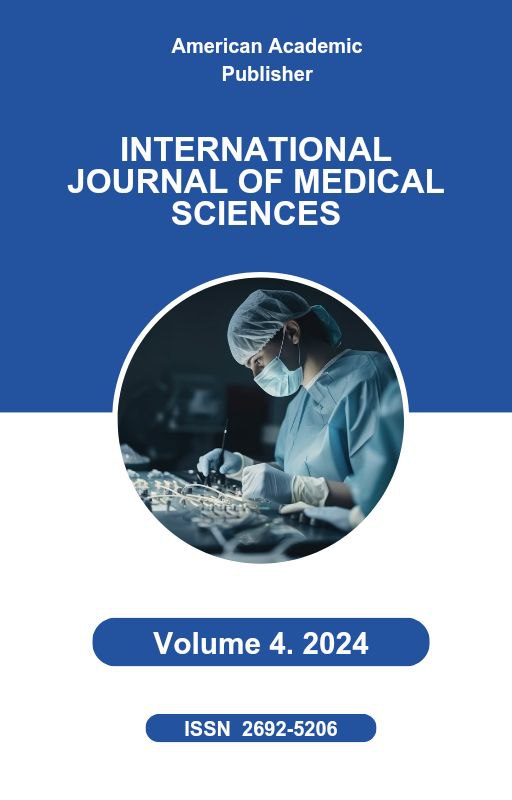 Articles
| Open Access |
https://doi.org/10.55640/
Articles
| Open Access |
https://doi.org/10.55640/
ENDOVENOUS LASER THERAPY: ANALYSIS OF EARLY EFFICACY AND COMPLICATIONS
Minavarkhujayev Ravshankhuja Raxmatkhuja ugli , Assistant of department General surgery №2, Tashkent Medical Academy Phlebologist at the "VarikozOFF" ClinicAbstract
Endovenous laser therapy (EVLT)—often referred to as endovenous laser ablation (EVLA)—has emerged as a highly effective, minimally invasive technique for the management of superficial venous insufficiency, most notably varicose veins of the lower extremities. By offering a safer alternative to traditional surgical stripping, EVLT quickly gained traction among vascular specialists due to its high success rates, favorable patient outcomes, and rapid recovery. Yet, despite its widespread adoption, potential complications and technical considerations must be well-understood to maximize the safety profile and achieve optimal early efficacy. This review provides an in-depth analysis of EVLT, focusing on mechanisms of action, early efficacy data, and complications that can arise in the early postoperative period. Emphasis is placed on recognizing risk factors, managing adverse events, and comparing EVLT with other contemporary therapies. Ultimately, the article underscores the importance of tailored patient selection, meticulous technique, and follow-up protocols to ensure both effectiveness and safety.
Keywords
References
Min RJ, Zimmet SE, Isaacs MN, Forrestal MD. Endovenous laser treatment of the incompetent greater saphenous vein. J Vasc Interv Radiol. 2001;12(10):1167-1171.
Gloviczki P, Comerota AJ, Dalsing MC, et al. The care of patients with varicose veins and associated chronic venous diseases: clinical practice guidelines of the Society for Vascular Surgery and the American Venous Forum. J Vasc Surg. 2011;53(5 Suppl):2S-48S.
van den Bos R, Arends L, Kockaert M, et al. Endovenous therapies of lower extremity varicosities: a meta-analysis. J Vasc Surg. 2009;49(1):230-239.
Morrison N, Gibson K, McEnroe S, Goldman MP, King T, Weiss RA. Randomized trial comparing endovenous laser ablation and radiofrequency ablation of the great saphenous vein. Phlebology. 2015;30(2):106-115.
Hamdan A. Management of varicose veins and venous insufficiency. JAMA. 2012;308(24):2612-2621.
Wittens C, Davies AH, Bækgaard N, et al. Editor’s Choice—Management of chronic venous disease: clinical practice guidelines of the European Society for Vascular Surgery (ESVS). Eur J Vasc Endovasc Surg. 2015;49(6):678-737.
Almeida JI, Kaufman J, Gockeritz O, et al. Radiofrequency endovenous closureFAST versus laser ablation for the treatment of great saphenous reflux: a multicenter, single-blinded, randomized study (RECOVERY study). J Vasc Interv Radiol. 2009;20(6):752-759.
Eroglu E, Yasim A. A randomized clinical trial comparing N-butyl cyanoacrylate glue and 1470-nm endovenous laser ablation for the treatment of venous insufficiency. Phlebology. 2018;33(6):361-367.
Brittenden J, Cotton SC, et al. A randomized trial comparing treatments for varicose veins. N Engl J Med. 2014;371(13):1218-1227.
Fan CM, Rox-Anderson R. Endovenous laser ablation mechanism of action: is a steam bubble event involved? Lasers Surg Med. 2008;40(1):13-18.
Piazza G, Goldhaber SZ. Varicose veins. Circulation. 2010;121(9):2070-2076.
Proebstle TM, Alm J, et al. Early results of combined endovenous laser treatment of the great saphenous vein and sclerotherapy of tributary varicosities. Phlebology. 2020;35(3):195-202.
Labropoulos N, Leon LR Jr. Definition and collateralization of superficial vein reflux and the role of perforators. Perspect Vasc Surg Endovasc Ther. 2013;25(2):59-62.
Article Statistics
Downloads
Copyright License

This work is licensed under a Creative Commons Attribution 4.0 International License.

